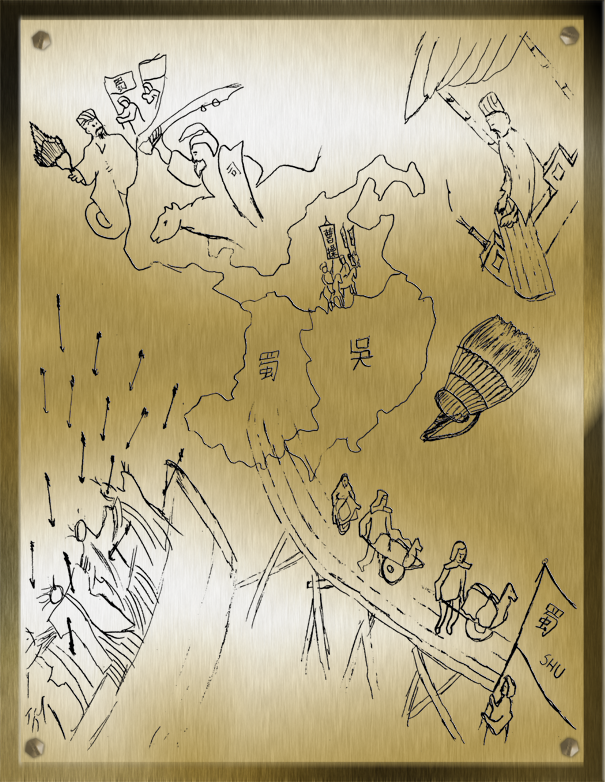| Time Period | Three Kingdoms Period (220-280 AD) |
| Geographical Region | Various regions of China, focused on Shu Kingdom (Zhuge Liang) |
| List of Symbols |
|
The person that is being conveyed for my Golden Plaque is Zhuge Liang, who is believed to be one of the greatest tacticians of his era. In order to show—through drawings—that he matches this timeless description, I drew pictures that represented his military tactics, his lifetime rival Sima Yi, his revolutionary invention of the Wooden Ox, and other important descriptive elements of his life. The time period for Zhuge Liang is the Three Kingdoms Period (220-280 AD), in which the Shu, Wei, and Wu Kingdoms were battling for control over China.
Zhuge Liang was a general for the Shu Kingdom, and was known for his cunning and brilliance on and off the battlefield. The main message for my Golden Plaque is to show the major instances in Zhuge Liang’s career that either showed his intelligence and strategy during battle or his inventions and other aspects of his life. The follwing symbols and descriptions with locations are listed below:
- Borrowing Arrows with Straw Boats (Bottom Left)
Zhou Yu presented a problem to Zhuge Liang in an attempt to kill him. He asks Zhuge Liang to obtain 100,000 arrows in ten days. Zhuge Liang replies by saying, “I only need three days.” Zhou Yu says if he fails to produce 100,000 arrows, he will be executed for failing to complete the mission. Zhuge Liang proceeded to fill 20 boats with straw scarecrows, under cover of heavy fog, to the Bank of the Yangtze. Cao Cao ordered 10,000 archers to shoot at the oncoming “enemy” boats; each boat quickly collected more than 5,000 arrows. By the end of the ordeal, 120,000 arrows had just been taken from the enemy, due to Zhuge Liang’s brilliance.
- Rival: Sima Yi (Top Left)
In 231, Zhuge Liang finally met his nemesis, Sima Yi (the newly appointed Wei commander), at the Battle of Mount Qi, the most vehement campaign of the 5 expeditions in terms of death toll. In 234, during the last northern expedition battle with the general of the Wei Sima Yi, Shu general Zhuge Liang died of exhaustion at Wuzhang Plain. Upon seeing Zhuge Liang’s encampments, Sima Yi declared that his adversary was a true genius. Throughout the years of battle between Wei and Shu kingdoms, Zhuge Liang and Sima Yi were consistantly facing each other in battle.
- Empty Fort Strategy (Top Right)
Sima Yi came to the undefended Shu city of Xicheng with 100,000 troops. Zhuge Liang ordered the gates to be wide open, in addition to a few old people cleaning the streets. As the Wei army approached the gates to the city, all they saw was Zhuge Liang sitting on the balcony playing his guqin calmly. Sima Yi suspected an ambush, and immediately ordered a retreat. In fact, Zhuge Liang only had 2,500 soldiers, which would have provided no resistance. This was an excellent and timeless example of how Zhuge Liang had a reputation for being a careful military tactician who took brilliant calculated risks.
- Wooden Ox And Flow Horse –Wheelbarrow invention (Bottom Right)
Zhuge Liang invented a mechanical replica of an ox, which he used as a means of delivery. Each ox had a wheel that resembled the modern day wheelbarrow, which his army used to carry 200 kilograms of grain up to 15 km away. They were capable of traveling 250 kilometers at a time, which allowed the Shu army to carry and provide grain and food for the 100,000 Shu troops.
- Map of the 3 Kingdoms, specifying Wei and Shu rivals (Center)
The map of the 3 Kingdoms, we can see that the Wooden Ox and Flow Horse are leading out of the Shu kingdom. We can also see Sima Yi’s army (wei) stationed in the Wei portion of the map, looking at Zhuge Liang playing his guqin at the gates (Empty Fort Strategy). Each of the three kingdoms are labeled with their respective Chinese character, with Wei troops carrying a banner with Cao Cao’s name on it. This map represents the specific time period in which the three kingdoms were warring during the period from 220-280 AD.
- Zhuge Liang’s crane-feather hand fan (Middle Right)
This is an iconic symbol of Zhuge Liang, as it is often associated with him in pictures and paintings. The legend says that Zhuge Liang obtained the crane feathers from a divine crane tail, and is a symbol that he should take great caution throughout the rest of his life, and take everything in its truest form, and not be tempted by lust or desire. Throughout the rest of his life, he is known to carry his crane feather hand fan everywhere.
In summary, Zhuge Liang has been known and associated with these events and symbols throughout history and modern day. Both battle strategies depicted, Empty Fort Strategy and Borrowing Arrows, demonstrate the cunning Zhuge Liang’s thought process. He introduced ideas of reverse psychology to fool the Wei army, and it may have been because of this that the Shu army was able to withstand the massive Wei army. In addition, he is remembered by his invention of the Wooden Ox, which is related to the modern day wheelbarrow. Zhuge Liang’s intense rivalry with Sima Yi shows the competition between the two warring kingdom leaders, and the battles that were fought to win victories on either side. His military accomplishments along with his pioneering inventions paved the way for future military tacticians in succeeding dynasties. His name –even his surname alone– has become synonymous with intelligence and strategy in Chinese culture.

RYAN ZU is a third-year Chemical Engineering student at the University of Rochester. Ryan is from Rochester and has a sister who lives in Seattle. In his spare time he enjoys reading and playing tennis. More by Ryan
